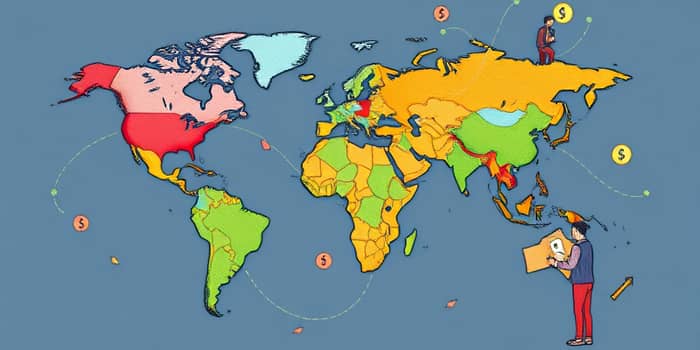As we step into 2025, the global economy faces the ongoing challenge of elevated prices. Investors seeking to preserve and grow wealth must grapple with the surging global inflation that has reshaped market dynamics since the pandemic. This detailed analysis explores current trends, regional nuances, policy shifts, and practical strategies for navigating an environment where price stability remains elusive.
Current Inflation Landscape in 2025
Inflation peaked near 9% in late 2022 due to pandemic-era supply disruptions and pent-up consumer demand. By late 2024, it had eased to below 5%, but early 2025 readings show an average global inflation rate of approximately 4.0%. This level remains elevated compared to the 2010s.
Several factors continue to drive prices upward, including robust wage growth, low unemployment, and less restrictive fiscal policies worldwide. Despite a general decline from its peak, inflation has proven sticky, with services and housing costs particularly resilient to downward pressure.
Regional Inflation Variations
Inflation does not move uniformly across the globe. Investors must recognize and anticipate divergent regional trends to allocate capital effectively.
- Asia: Lowest projected inflation in 2025, tempered by excess manufacturing capacity and soft consumer demand in China (0.5% in January 2025).
- G7 Economies: Target-aligned inflation around 2.0%, driven by credible central bank frameworks.
- Middle East & North Africa: Moderate inflation supported by currency pegs and energy subsidies.
- Latin America & Eastern Europe: Higher inflation following currency depreciation and interest rate cuts.
- Sub-Saharan Africa: Highest inflation, exacerbated by currency instability and economic management challenges.
Understanding these regional disparities helps investors tailor portfolios to areas of potential outperformance or heightened risk.
Central Bank Policies and Interest Rates
After aggressive rate hikes through 2022 and 2023, major central banks have shifted toward cuts since mid-2024. The Federal Reserve, Bank of England, and European Central Bank adopted a more cautious easing path, reflecting mixed inflation signals and concerns about financial stability. Their central banks' cautious stance underscores the delicate balance between curbing inflation and supporting growth.
This table highlights the wide dispersion of monetary stances, which shapes capital flows and currency valuations globally. High-rate environments can attract yield-seeking funds, while ultra-low rates may spur equity investments.
Inflation Outlook and Projections
Looking ahead, economists forecast a global average inflation rate of 4.0% in 2025, inching down to 3.9% in 2026, and settling near 3.8% by 2028. These projections reflect the interplay between persistent structural pressures and eventual policy normalization.
Long-term forecasts have ticked higher in recent quarters, signaling that markets and central banks may have adjusted expectations about the durability of post-pandemic price shocks. Investors should brace for persistently above-target inflation that could require prolonged monetary vigilance.
Key Factors Influencing Inflation in 2025
- Trade Restrictions: Rising protectionism adds upward pressure on import costs.
- Energy & Food Prices: Softening commodity prices may help contain headline inflation.
- Policy Uncertainty: New tariffs or fiscal measures could create fresh price volatility.
- Economic Momentum: Ongoing strength in consumer spending supports job growth and wage gains.
- Supply Chain Normalization: Continued recovery from logistical disruptions influences cost dynamics.
Monitoring these drivers allows investors to anticipate shifts in both headline and core measures of inflation.
Inflation Measurement
Precise measurement is vital. The consumer price index (CPI) remains the most widely cited gauge, reflecting changes in a basket of goods and services consumed by households. Other key indicators include the Producer Price Index (PPI), Employment Cost Index (ECI), and the GDP Deflator.
The Federal Reserve’s preferred PCE Price Index showed headline inflation at 2.4% and core inflation (excluding volatile food and energy) at 2.8% as of early 2025. Differences between CPI and PCE highlight the importance of looking beyond a single statistic when evaluating trends.
Investment Implications
Inflationary pressures have far-reaching consequences for asset allocation and risk management. Recognizing how price growth influences returns across asset classes is critical for portfolio resilience.
- Fixed-Income Strategies: Rising rates can erode bond prices, requiring careful duration management.
- Equity Valuations: Higher discount rates may compress price-to-earnings multiples, impacting growth stocks more severely.
- Currency Fluctuations: Interest rate differentials drive exchange rates, affecting returns on international holdings.
- Commodity Exposure: Hard assets like energy and metals often serve as inflation hedges.
- Real Assets: Real estate and infrastructure investments can provide income streams that adjust with inflation.
Strategies for Investors
In an inflationary regime, diversification and active management become paramount. Begin by reviewing portfolio sensitivity to interest rate movements and consider reallocating to shorter-duration bonds. Incorporating inflation-protected securities, such as TIPS, can help preserve real purchasing power. Equities in sectors with strong pricing power—consumer staples, utilities, and select technology firms—may sustain margins even as costs rise.
Global diversification into regions with lower projected inflation or supportive central bank policies can offer relative stability. Finally, maintain a flexible cash reserve to capitalize on market dislocations and to adjust positions when new economic data emerges. By combining rigorous analysis with adaptive strategies, investors can navigate the complexities of 2025’s inflation trends and position portfolios for resilient long-term growth.
References
- https://www.imf.org/external/datamapper/PCPIPCH@WEO/WEOWORLD
- https://tradingeconomics.com/forecast/inflation-rate
- https://www.worldbank.org/en/research/brief/inflation-database
- https://www.focus-economics.com/blog/global-inflation-rates/
- https://www.ifo.de/en/facts/2025-04-09/economic-experts-survey-experts-expect-inflation-rates-rise-worldwide
- https://www.morningstar.com/markets/why-inflation-still-poses-risk-stocks-bonds-2025
- https://www.bls.gov/cpi/questions-and-answers.htm
- https://www.statista.com/statistics/1317878/inflation-rate-interest-rate-by-country/










